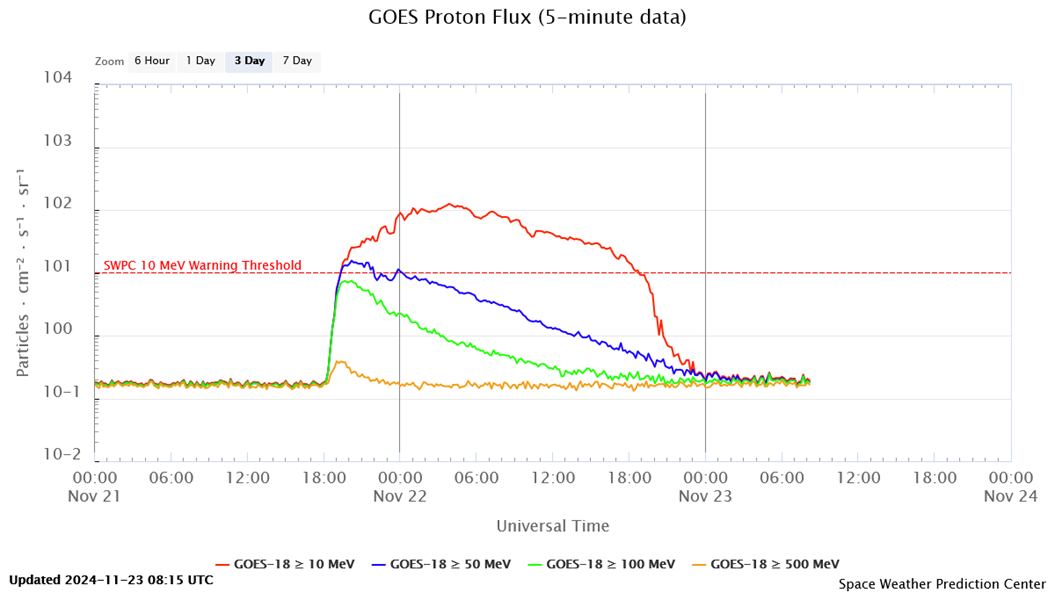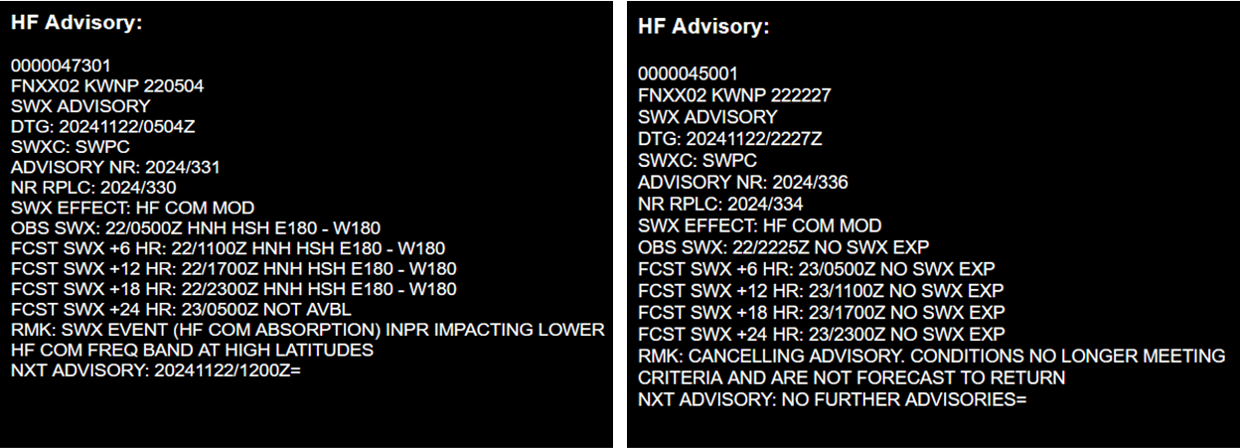In what was all-in-all a relatively quiet week with only a dozen or so low-level M-class flares, a proton event started on 21 November at 19:25UTC (GOES). The greater than 10 MeV proton flux would reach a maximum of 125 pfu on 22 November at 03:55UTC, and dipping already back below the 10 pfu alert threshold the same day at 18:45UTC. Also, the greater than 100 MeV increased, reaching a peak of 7.4 pfu on 21 November at 20:10UTC. This can be seen in the graph underneath, with different colors showing the fluxes of different energies of the protons. The red curve represents the greater than 10 MeV proton flux.

In view of the response from the high energy protons, one would assume a strong flaring event to have taken place. However, the GOES did not record a significant flare around that time. More info came from coronographic imagery of the SOHO, showing a powerful coronal mass ejection (CME) in the northwestern ("upper right") direction first visible at 18:12UTC. This can be seen in the LASCO C3 imagery underneath covering both 21 and 22 November (before/after image). According to CACTus (SIDC), this partial halo CME was fast with a plane-of-the-sky speed around 1100 km/s. Space weather forecasters all concluded that this CME was not earth-directed. The CME's emergence coincided with the increase in "noise" in the coronagraphic imagery, due to the impact of the protons on the camera's pixels. So, just to be clear, around 19:00UTC, the protons -which travel at a substantial fraction of the speed of light- have already arrived at Earth, whereas the much slower CME has only just been ejected and is still relatively close to the Sun.

So, what was the origin of this proton event? Here the STEREO-A spacecraft was of great help. This satellite is currently leading the Earth by about 28 degrees, and so it can see a bit of the Sun's farside that is not visible from Earth (beyond the west limb - see this map). It has a telescope that observes the Sun in extreme ultraviolet (EUV) in 4 different wavelengths. At 19.5 nm (see the imagery underneath), it shows indeed a strong solar flare starting around 18:00UTC and reaching a maximum around 18:15UTC (compilation). From the width of the spike -caused by saturation of the camera's pixels"-, a soft x-ray (SXR) intensity of X3.0 is obtained (see Chertok et al. 2015 for the methodology ; this STCE newsitem discusses another farside event). Correcting for the downscaled GOES SXR values prior to GOES-16 (NCEI/NOAA), a value in the range between X2.1 and X6.4 is obtained, with X4.3 the most likely intensity for this flare. Even for STEREO-A, the flare was located at the Sun's west limb, meaning that the source of the flare was at least 28 degrees beyond the Sun's west limb as seen from Earth. A very likely candidate is then NOAA 13889 which fully rounded the west limb late on 19 November. This region was an active M-class flare producer (22!) during its transit over the solar disk. Some interaction with nearby NOAA 13897 is not excluded. At any rate, this must have been quite a complex eruption, taking place at the west-southwest limb but ejecting the CME in the northwestern direction.

The observed intensity of the proton event corresponds to an S2 solar radiation storm (see the NOAA scales). The associated impacts seem to have been restricted to minor degradation of the High Frequency communication (HF Com ; 3-30 MHz) over the Earth's polar regions, as well as some minor impact on the data and communication stream from satellites (the so-called single event upsets (SEU) or "bit flips") and increased "noise" in imagery and for their star-trackers. Though the high latitude neutron monitors recorded some enhancement in the neutron counts, not all conditions seem to have been fulfilled to make this a Ground Level Enhancement (see the SC25 Tracking page for more info on GLEs). No advisory was sent to the civil aviation for radiation hazard, only for potentially degraded HF Com (PECASUS/SWPC).






